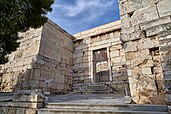Wikipedia:Today's featured article/May 29, 2024
The Beulé Gate is a fortified gate leading to the Propylaia of the Acropolis of Athens, Greece. It was constructed largely of repurposed material taken from the 4th-century BCE Choragic Monument of Nikias and integrated into the Post-Herulian Wall, a late Roman fortification built around the Acropolis in the years following the city's sack by the Germanic Heruli people in 267 or early 268 CE. Its construction marked the beginning of a new phase in the Acropolis's use, in which it came to be seen more as a defensive position than a religious sanctuary. During the medieval period, the gate was further fortified, before being built over with a bastion in Ottoman times. The monument was discovered by the French archaeologist Charles Ernest Beulé on 29 May 1852, and excavated in 1852 and 1853. Archaeologists and Greek commentators criticised the aggressive excavation – particularly the use of explosives. In modern times, the gate has served primarily as an exit for tourists from the Acropolis. (Full article...)
